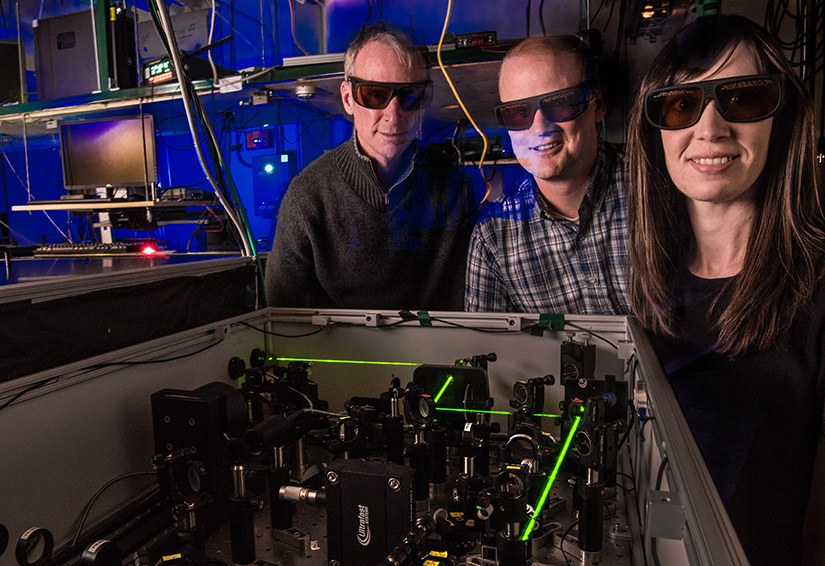Understanding Bifurcating Enzymes Could Lead to More Efficient Renewable Fuel and Chemical Production
With Support From DOE’s Basic Energy Sciences Program, NREL Researchers Unravel the Atomic-Level Mysteries of Flavin-Based Electron Bifurcation
Enzymes equal life: Without these biological catalysts, metabolic reactions that drive bacterial, plant, and animal growth would not occur at the speed necessary to sustain life.
There are multiple ways that organisms control and manipulate energy for cellular metabolism and survival. One method, and the focus of an award-winning National Renewable Energy Laboratory (NREL) research team, is flavin-based electron bifurcation (FBEB).
Fully understanding the complex biochemistry of FBEB could help design enzymatic processes so that energy from biomass or waste resources may be more effectively used for production of biobased fuels or commodity chemicals at lower environmental and economic costs.
Funding from the U.S. Department of Energy’s Office of Science Basic Energy Sciences program (DOE-BES) supported the FBEB research at NREL through the Center for Biological Electron Transfer and Catalysis (BETCy), a DOE-BES-funded Energy Frontier Research Center; the Photosynthetic Energy Transduction DOE-BES-funded Core Program; and a DOE-BES Early Career Award to Cara Lubner.
“The NREL team’s work on bifurcation provides critical underpinning science for improving processes for more efficient renewable fuels and chemicals,” said Bill Tumas, associate laboratory director of the Materials, Chemical, and Computational Science directorate and BES point of contact at NREL.

Paul King, David Mulder, and Cara Lubner (left to right) helped drive the understanding of energy conservation in flavin-based electron bifurcation. This important research resulted in a British Royal Society of Chemistry 2023 Faraday Horizon Prize. Photo by Dennis Schroeder, NREL
Exploring the Mechanistic Mysteries of Flavin-Based Electron Bifurcation
FBEB recently gained acceptance as a fundamental mechanism of biological energy generation and conservation. The unknown was how this mechanism worked.
So a team from NREL and partner universities across the country started their investigation into the mysteries of the FBEB mechanism. Cara Lubner, David Mulder, and Paul King led the NREL team and examined previously unknown features of flavin-based enzymes to understand how they generate two levels of energy during the FBEB reaction.
They discovered key design features of FBEB enzymes that allow for the energy level of an electron pair to be bifurcated into low and high energy levels that are split between chemical reactions that have different energy requirements.
“The team’s insights have uncovered how electrons are shuttled around in the heart of an enzyme, to understand how the enzyme solves the problem of conducting an energy-intensive chemical reaction at room temperature and pressure,” said Maureen McCann, director of NREL’s Biosciences Center. “In the long term, this knowledge of fundamental mechanisms at the atomic and electronic levels opens up transformational approaches to drive energy-intensive chemical reactions at the industrial scale.”
NREL’s Unique Technical Capabilities Enable an Atomic-Level View Into FBEB Enzymes
To decipher the inner workings of the FBEB enzymes, the team leveraged unique technical capabilities at NREL, including the Advanced Spin Resonance Facility and the Ultrafast Optical Biophysics Laboratory for electron paramagnetic resonance (EPR) and transient absorption spectroscopic approaches.
Together, these made it possible to probe at the atomic level how the enzyme electronic circuitry, which contains a flavin cofactor and iron-sulfur clusters, enables the partitioning of pairs of electrons in reactions between substrates and products.
The results uncovered key thermodynamic and electron-spin properties of the circuitry that ultimately is responsible for controlling electron flow within the enzyme to result in FBEB. Because FBEB is a departure from what normally occurs during a metabolic reaction, i.e., loss of energy as heat and production of lower-energy products, the result is the conservation of energy.
The team published this study, “Mechanistic insights into energy conservation by flavin-based electron bifurcation,” in Nature Chemical Biology.
NREL Researchers Receive 2023 Faraday Horizon Prize for Electron Bifurcation Research
This groundbreaking work on electron bifurcation also resulted in additional accolades. NREL’s Cara Lubner, David Mulder, and Paul King and multiple university partners were awarded the British Royal Society of Chemistry’s 2023 Faraday Horizon Prize.

The Faraday Horizon Prizes recognize significant recent novel discoveries or advances made in physical chemistry. The award was given for “successfully unravelling the rules underpinning how living systems split apart pairs of electrons into high and low energy pools, without producing energy wasting ‘short-circuiting’ reactions.”
Congratulations to the NREL team and the university partners for this award.
Learn more about basic energy science at NREL or the U.S. Department of Energy Office of Science.
Last Updated May 28, 2025
